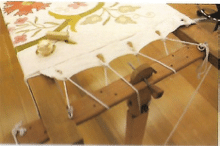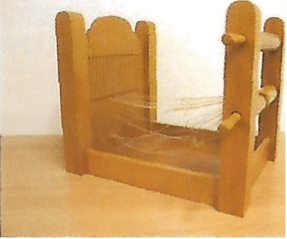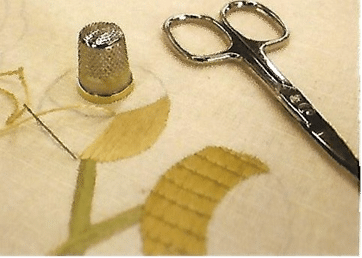MODE OF PRODUCTION
In Castelo Branco embroidery there is always an underlying design. In the historic quilts, this design was made by debuxadores, by quill and with ferrogalic ink. Later, from the late 19th and 20th centuries, the drawings, existing on tracing paper, were (and still are) transferred to carbon paper. More than defending a specific process of the passage of the design to the fabric, we must insist on the quality of the design, a necessary condition for the good execution of embroidery.
Rack

The embroidery of Castelo Branco uses a horizontal frame (rectangular or quadrangular), standing, a structure composed of two perforated wooden slats that fit into two others, on which the linen fabric is to be rolled. These slats fit into two feet that give height to the frame and stabilize it. On the top of the two feet there are pegs that allow you to change the position of the work. Special attention must be paid to the mounting of the fabric on the hoop, which must be aligned and tightly stretched so that the design is not distorted.
Fringe Loom (manual or mechanical)

With the exception of quilts, fringing is not obligatory, but when it exists, fringing can be done either on a hand loom or on a machine loom. Very simple in structure, the fringe loom (manual) is composed of a box measuring approximately 10x30cm where, at the top, a board about 28cm high fits, with holes equidistant in the middle and, between each hole, two grooves. At the other end of the box is a small organ with a crank and a hole that is used to insert the pin and lock it.
The mechanical fringe loom can also be used and in no way compromises the quality and final result of the fringe.
Utensils

The tools used in Castelo Branco's embroidery are the needle, the thimble, and the scissors.
